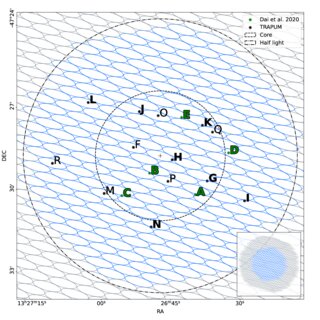In the vast expanse of the universe, where mysteries abound and celestial bodies dance in cosmic ballets, the discovery of three new millisecond pulsars within the globular cluster Messier 62 (M62) has stirred the curiosity of astronomers worldwide. Led by the University of Manchester’s Laila Vleeschower, an international team of astronomers utilized the remarkable capabilities of the MeerKAT radio telescope in South Africa to peer deep into the heart of M62, uncovering these elusive cosmic gems.
Pulsars, those enigmatic remnants of massive stars, hold within them a trove of information about the universe’s evolution, gravitational dynamics, and extreme physics. Rapidly rotating and highly magnetized, millisecond pulsars represent a unique class of these cosmic beacons, offering insights into the dynamics of binary star systems and the mysterious processes governing neutron stars.
The quest to unveil the secrets of M62 began with the TRAnsients and PUlsars with MeerKAT (TRAPUM) project, a collaborative effort aimed at exploring transient phenomena and pulsars within our galaxy and beyond. Harnessing the unparalleled sensitivity and resolution of MeerKAT, the astronomers embarked on a journey to unravel the mysteries concealed within this ancient globular cluster.
In a research paper published on the pre-print server arXiv, the team unveiled their groundbreaking discovery—three new millisecond pulsars nestled within the dense stellar population of M62. Dubbed M62H, M62I, and M62J, these pulsars dazzle with their rapid spins and intricate orbital dances, shedding light on the complex interactions shaping the cosmic landscape.
M62H, the lightest binary companion yet discovered within a globular cluster, captivates with its mesmerizing spin period of 3.7 milliseconds and a companion of minuscule mass—2.5 times that of Jupiter. Orbiting its stellar partner in a mere 0.133 days, M62H challenges our understanding of stellar evolution and binary dynamics within globular clusters.
Meanwhile, M62I spins with remarkable swiftness, completing a rotation in just 3.3 milliseconds. Its orbital period of 0.51 days hints at a celestial waltz spanning cosmic epochs. With a minimum companion mass of 0.15 solar masses, M62I unveils the intricate interplay between pulsars and their stellar companions, offering a glimpse into the evolutionary pathways of these cosmic relics.
M62J, shrouded in mystery, presents astronomers with tantalizing questions yet to be answered. With a spin period of 2.76 milliseconds and an enigmatic dispersion measure, M62J beckons researchers to delve deeper into its cosmic enigma, promising revelations yet unseen.
Beyond the discovery of these celestial marvels, the team’s endeavors yielded a treasure trove of data, enabling the refinement of long-term timing solutions for six previously known pulsars within M62. Spanning over 23 years, these updated solutions offer a glimpse into the dynamic evolution of pulsar systems within this ancient globular cluster.
The significance of these findings extends far beyond the confines of M62, resonating throughout the realm of astrophysics. By unraveling the mysteries of millisecond pulsars within globular clusters, astronomers gain invaluable insights into the cosmic processes driving stellar evolution, binary interactions, and the intricate dance of gravity on cosmic scales.
As the MeerKAT telescope continues to probe the depths of the cosmos, astronomers stand poised on the precipice of discovery, ready to unlock the secrets of the universe one pulsar at a time. With each new revelation, we inch closer to understanding the profound mysteries that shroud the cosmos, illuminating the path toward a deeper comprehension of the universe’s intricate tapestry.
